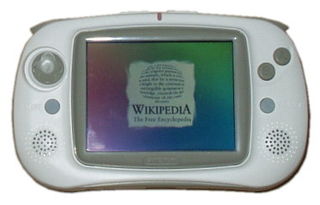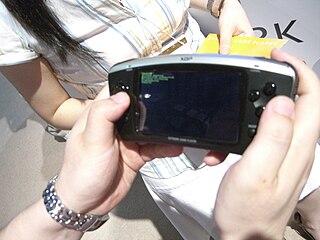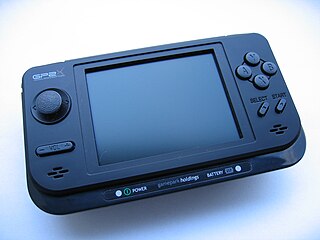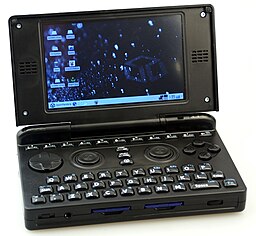
The GP32 is a handheld game console developed by the South Korean company Game Park. It was released on November 23, 2001, in South Korea and distributed in some parts of Europe.

Albion is a single player role-playing video game developed and published by Blue Byte for MS-DOS in 1995. It was originally released in German, then translated to English for international release. The game uses a science fiction setting that incorporates traditional fantasy elements, such as magic.

The OMAP family, developed by Texas Instruments, was a series of image/video processors. They are proprietary system on chips (SoCs) for portable and mobile multimedia applications. OMAP devices generally include a general-purpose ARM architecture processor core plus one or more specialized co-processors. Earlier OMAP variants commonly featured a variant of the Texas Instruments TMS320 series digital signal processor.

OpenEmbedded is a build automation framework and cross-compile environment used to create Linux distributions for embedded devices. The OpenEmbedded framework is developed by the OpenEmbedded community, which was formally established in 2003. OpenEmbedded is the recommended build system of the Yocto Project, which is a Linux Foundation workgroup that assists commercial companies in the development of Linux-based systems for embedded products.
This is a comparison of the features of various handheld game consoles.

The XGP was a concept portable video game system created by the Korean company GamePark as the follow-up to its GP32 handheld. Initially announced in 2005, the XGP was finally announced in March 2006 along with the release of the similar XGP Mini and the XGP Kids. The company went bankrupt before releasing any of the models.

The GP2X is a Linux-based handheld video game console and portable media player developed by South Korean company GamePark Holdings. It was released on November 10, 2005, in South Korea only.
GPH, formerly known as GamePark Holdings, was a South Korean company responsible for creating the GP2X that was founded by former employees of the game maker GamePark in 2005.
Egoboo is a 3D open source dungeon crawling action role-playing game with support for Windows XP, Windows Vista, Linux, Mac OS X, and some earlier versions of Windows. Egoboo has been downloaded over 590,000 times since its first release over SourceForge alone until mid 2016, while Egoboo can be downloaded from other sources as well.

The BeagleBoard is a low-power open-source single-board computer produced by Texas Instruments in association with Digi-Key and Newark element14. The BeagleBoard was also designed with open source software development in mind, and as a way of demonstrating the Texas Instrument's OMAP3530 system-on-a-chip. The board was developed by a small team of engineers as an educational board that could be used in colleges around the world to teach open source hardware and software capabilities. It is also sold to the public under the Creative Commons share-alike license. The board was designed using Cadence OrCAD for schematics and Cadence Allegro for PCB manufacturing; no simulation software was used.

The GP2X Wiz is a handheld game console and portable media player developed by South Korean company GamePark Holdings running a Linux kernel-based embedded operating system. It was released on May 12, 2009, and was also the first console from both Game Park and Game Park Holdings to be also released outside South Korea. It is the successor to the GP2X.

The Dingoo is a handheld gaming console that supports music and video playback and open game development. The system features an on-board radio and recording program. It is available to consumers in three colors: white, black, and pink. It was released in February 2009 and has since sold over 1 million units.
The IGEPv2 board is a low-power, fanless single-board computer based on the OMAP 3 series of ARM-compatible processors. It is developed and produced by Spanish corporation ISEE and is the second IGEP platform in the series. The IGEPv2 is open hardware, licensed under a Creative Commons Attribution-Non Commercial-ShareAlike 3.0 unported license.

The GP2X Caanoo, more commonly known as Caanoo, stylized CAANOO, is an open source, Linux-based handheld video game console and portable media player developed by the South Korean company GamePark Holdings. It was released on August 16, 2010 in South Korea and were also sold throughout Europe. It is the successor to the GP2X Wiz, and was showcased at the Electronic Entertainment Expo 2010. The device's launch price was about US$150, which didn't reach any retail stores in North America.
The Game Gadget is an open source gaming handheld that supports music and video playback, open game development, and some e-reader features. It was available in one colour (white). It was released on April 5th, 2012.
Game engine recreation is a type of video game engine remastering process whereby a new game engine is written from scratch as a clone of the original with the ability to load the original game's data files such as music, textures, scripts, shaders, levels, and more. The new engine should read these data files and, in theory, load and understand them in a way that is indistinguishable from the original. The result of a proper engine clone is often the ability to play a game on modern systems that the old game could no longer run on. It also opens the possibility of community collaboration, as many engine remake projects tend to be open source. Game engine recreation can be beneficial to game publishers because the legal use of a re-creation still requires the original data files, as a player must still purchase the original game in order to legally play the re-created game.

The DragonBox Pyra is an upcoming Linux-based handheld computer equipped with a keyboard and gaming controls. The project entered prototyping stage in 2015. Pre-orders began on 1 May 2016, with a final release date still undefined. In August 2020 the first production model had been shipped, but only to developers, as the software wasn't ready. As of November 2021, preorders were shipping in the order received.

The GCW Zero is a Linux-based open-source handheld video game console created by a start up, Game Consoles Worldwide. The GCW Zero was funded by a successful crowdfunding campaign on kickstarter.com on 29 January 2013 with US$238,499 collected, originally aiming for $130,000. The project was created by Justin Barwick. The device was eventually released that year.

GPD Win is a Windows-based handheld computer equipped with a keyboard and gaming controls. It is an x86-based device which runs a full version of Windows 10 Home. The device was envisioned primarily with video game console emulation and PC gaming in mind, but is capable of running any x86 Windows-based application that can run within the confines of the computer's technical specifications. First announced in October 2015, it was crowdfunded via Indiegogo and two other crowdfunding sites in Japan and China, and was released in October 2016.

















